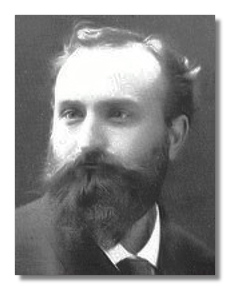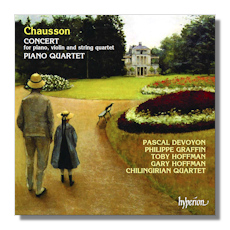
The Internet's Premier Classical Music Source
Related Links
-
Find CDs & Downloads
Amazon - UK - Germany - Canada - France - Japan
ArkivMusic - CD Universe
Find DVDs & Blu-ray
Amazon - UK - Germany - Canada - France - Japan
ArkivMusic-Video Universe
Find Scores & Sheet Music
Sheet Music Plus -
Recommended Links
Site News
Ernest Chausson

(1855 - 1899)
Amédée-Ernest Chausson (January 20, 1855 - June 10, 1899) was a French romantic composer born into a wealthy Parisian family. He initially studied law and became a lawyer at the Court of Appeals. At the age of 25 he began attending composition classes at the Paris Conservatoire taught by the opera composer Jules Massenet. It is from these lessons that Chausson's earliest manuscripts survive. Beginning in 1886 Chausson was secretary of the Société Nationale de Musique, and remained in that position until his death. It was through these activities that he befriended composers Henri Duparc, Gabriel Fauré, Claude Debussy, and Isaac Albéniz, the poet Stéphane Mallarmé, the Russian novelist and playwright Ivan Turgenev, and the impressionist painter Claude Monet.
Chausson's artistic vision, though extremely individual, does reflect the influences of both César Franck and Richard Wagner, as well as traces of Massenet and even Johannes Brahms. His orchestral output was small, but significant and includes his singular Symphony in B Flat Major, completed in 1890. The Turgenev-inspired Poème for Violin and Orchestra from 1896 is a mainstay of the violin repertoire. Owing to his late start, and tragically short life, Chausson left behind only 39 numbered works.
Recommended Recordings
Concert for Violin, Piano & String Quartet
- Concert, Op. 21; Piano Quartet Op. 30/Hyperion CDA66907
-
Pascal Devoyon (piano), Philippe Graffin (violin), Chilingirian String Quartet
- Concert, Op. 21; String Quartet Op. 35, Piano Quartet Op. 30, Piano Trio Op. 3/Classic Talent DOM291006
-
Jerrold Rubenstein (violin), Dalia Ouziel (piano), Sharon String Quartet
- Concert, Op. 21; Pièce for Cello & Piano Op. 39/Harmonia Mundi HMC901135, reissued as Musique d'Abord HMA1951135
-
Régis Pasquier (violin), Jean-Claude Pennetier (piano), Roland Daugareil (violin), Genevieve Simonot (violin), Bruno Pasquier (viola), Roland Pidoux (cello)
"Poème" for Violin & Orchestra
- Poème, Op. 25 w/ Elgar/Avie AV2091
-
Philippe Graffin (violin), Vernon Handley/Royal Liverpool Philharmonic Orchestra
- Poème, Op. 25; Symphony Op. 20, Poème de l'amour et de la mer Op. 19/Decca 458010-2
-
Chantal Juillet (violin), Charles Dutoit/Montreal Symphony Orchestra
- Poème, Op. 25 w/ Ravel & Saint-Saëns/EMI CDC7477252
-
Itzhak Perlman (violin), Jean Martinon/Orchestra Of Paris
- Poème, Op. 25 w/ Ravel & Saint-Saëns/London 417118-2
-
Kyung-Wha Chung (violin), Charles Dutoit/Royal Philharmonic Orchestra
Symphony in B Flat Major
- Symphony, Op. 20 w/ Franck/Pentatone SACD 5186078
-
Marek Janowski/Suisse Romande Orchestra
- Symphony, Op. 20; Soir de fête Op. 32, La Tempête Op. 18/Chandos CHAN8369
-
José Serebrier/Belgian Radio Symphony Orchestra
- Symphony, Op. 20; Soir de fête Op. 32, Vivian Op. 5/EMI CDM7646862
-
Michel Plasson/Toulouse Capitole Orchestra
- Symphony, Op. 20; Soir de fête Op. 32, La Tempête Op. 18, Vivian Op. 5/Chandos CHAN9650
-
Yan Pascal Tortelier/BBC Symphony Orchestra
- Symphony, Op. 20 w/ Barraud & Lalo/Mercury Living Presence
-
Paul Paray/Detroit Symphony Orchestra
















